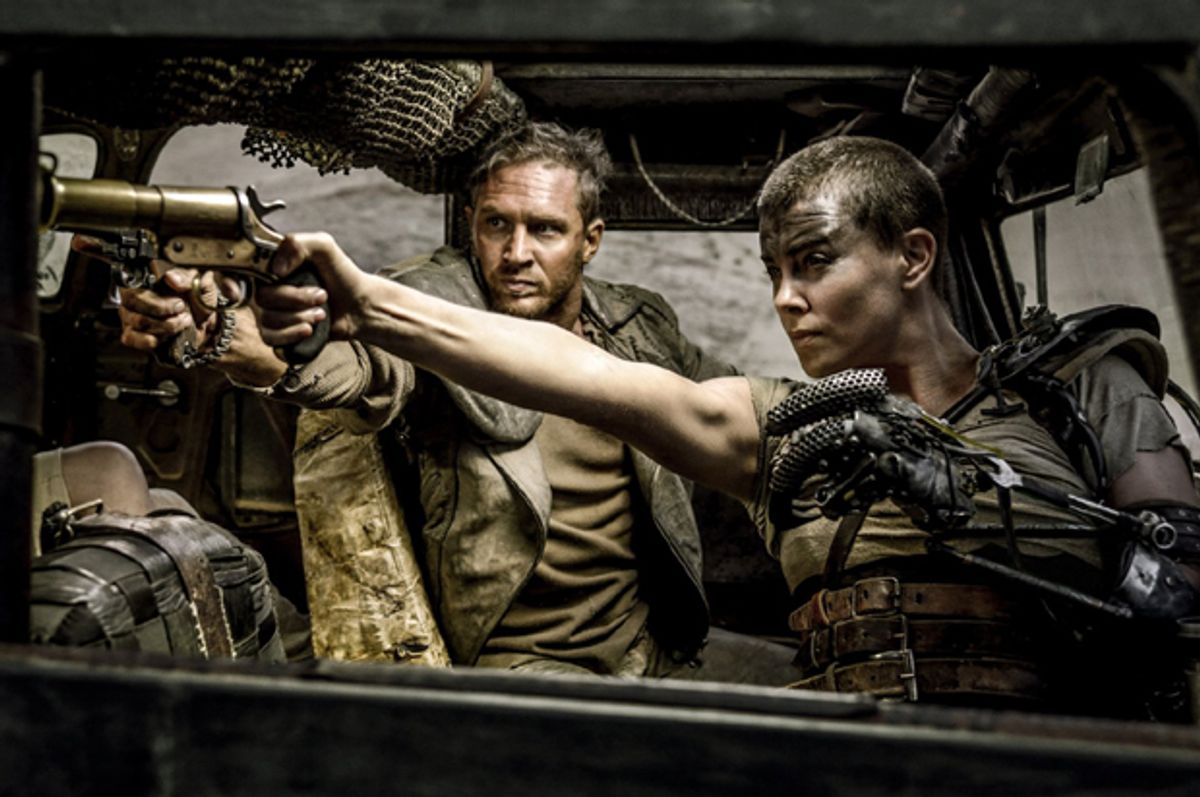It didn't seem possible, and yet here we are. "Mad Max: Fury Road" has received an Oscar nomination for best picture. While there's been a lot of chatter about this possibility, it's one of those things that are impossible to believe can happen until they do. The movie, which barely has any dialogue, is a sequel to a cult action series from the '80s, and is the fun kind of sci-fi instead of the ponderous Kubrick-style sic-fi, was popular with audiences but defies every stereotype of what the Oscar voters usually want in a movie.
This is no bedroom drama or feel-good blockbuster about a white man saving the natives. This is a movie that features a C-section on a dead woman being performed in a car. That it got nominated at all is a miracle.
But the truth is that it's not enough to be nominated. "Mad Max" deserves to win.
Many of the other best picture nominees are great movies. (I particularly found myself moved by "Spotlight," about the Boston Globe's investigation into the cover-up of pedophile priests.) But "Mad Max" is more than just a really good movie. It's also a wildly innovative movie, one that plays with the very idea of filmmaking itself. The director, George Miller, tore up the book on how to make a movie, taking huge risks in doing so, and ended up making the movie that people could not stop talking about this year.
"Mad Max" barely has a script. There was heavy storyboarding, but in terms of a traditional script for actors to work from, nope. Instead, they filmed for months in the desert, collecting 480 hours of footage (which is three weeks, if you watch non-stop), which was pounded and then refined into a coherent story in the editing bay, with Margaret Sixel, Miller's wife, at the helm.
"I think the hardest thing for us, as actors, to get our heads around, was that the movie really was one big scene," star Charlize Theron told io9. "Usually you have scenes and this was one big scene. So we shot one big scene for 138 days."
Tom Hardy, who plays Max, admitted in public that it was hard to film because of this turn away from convention, but declared the final product "brilliant" and apologized for doubting that it was anything but worth it.
If some art house director made a movie about, say, the malaise-inflected ill behavior of the fading gentry by filming nearly 500 hours of footage of actors banging around an Italian mansion and then sculpting it into a movie in edits, that this would be considered a major artistic achievement would be inarguable. Doubly so if the finished product managed to tell a moving story with minimal dialogue, with most emotion being conveyed through blocking and meaningful glances between actors. It would be a triumph of cinema, a profound statement on what movies have to offer the art of storytelling that theater and novels cannot provide.
Well, that is exactly what "Mad Max" is, even if it pulls the stunt off with car chases and cartoonish violence, instead of gazing out of windows while the music subtly swells in the background. The fact that it's such a fun movie shouldn't distract from the fact that it's also an artistic experiment toying with how to use the tools of film-making to tell a story in an entirely different way than we're used to.
Editing is what makes movies special, after all. Not every movie has special effects or big name actors or the ability to film on location in beautiful but remote areas. But every movie constructs its story out of shots, little splices of time and focus, usually lasting mere seconds (or less), quilted together to create the impression of a coherent narrative moving forward in time. What "Mad Max" does is take this fact and rub the audience's noses in it.
The meta nature of the movie isn't just limited to its self-aware editing style. There's a number of hilarious bits of pointed self-awareness, where Miller is subverting and satirizing the cliches of action films, while still celebrating the form itself. The guitarist strapped to front of the car leading the charge to kidnap the fleeing women? The scene where Max watches the escaped wives wearing barely any clothes while dousing each other in water, in slow motion? Every ridiculous stunt they do with cars and motorcycles? These moments are over-the-top, but they are meant to be---we're supposed to be laughing at the way that movies use music, sexuality, and heart-stopping action to manipulate our emotions, and laughing at ourselves for loving it every step of the way.
There's almost no chance of "Mad Max" wining, of course. Oscar voters lean conservative and this movie, which is provocative and strange and doesn't hand-hold the viewers, is probably going to alienate too many of them to make it to the top. The fact that it's a goofy sci-fi film will be enough for some voters to write it off as too unserious to count as a legitimate Best Picture winner.
That's too bad, though. "Mad Max" isn't just a fun movie that is extraordinarily well-made. It's an experimental movie that has a lot to say about the art of film-making itself: What makes movies work and what draws audiences to them. It's a blockbuster film that doesn't talk down to its audience. It's a live action cartoon, and yet the characters all feel ultimately very human and their stories linger with you. It doesn't have a bear attacking Leonardo di Caprio, but still, "Mad Max" is a singular achievement, one that should be recognized by the Academy.


Shares